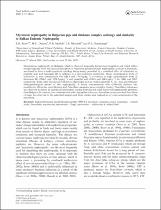 ResearchSpace
ResearchSpace
Mycotoxic nephropathy in Bulgarian pigs and chickens: complex aetiology and similarity to Balkan endemic nephropathy
JavaScript is disabled for your browser. Some features of this site may not work without it.
- ResearchSpace
- →
- Research Publications/Outputs
- →
- Journal Articles
- →
- View Item
| dc.contributor.author |
Stoev, SD

|
|
| dc.contributor.author |
Dutton, MF

|
|
| dc.contributor.author |
Njobeh, PB

|
|
| dc.contributor.author |
Mosonik, JS

|
|
| dc.contributor.author |
Steenkamp, PA

|
|
| dc.date.accessioned | 2010-08-23T13:09:56Z | |
| dc.date.available | 2010-08-23T13:09:56Z | |
| dc.date.issued | 2009 | |
| dc.identifier.citation | Stoev, SD, Dutton, MF, Njobeh, PB. 2009. Mycotoxic nephropathy in Bulgarian pigs and chickens: complex aetiology and similarity to Balkan endemic nephropathy. Food Additives and Contaminants, Part A: Chemistry Analysis Control Exposure & Risk Assessment, Vol. 27(1), pp 72-88 | en |
| dc.identifier.issn | 1944-0049 | |
| dc.identifier.uri | http://pdfserve.informaworld.com/929781_769431896_914865098.pdf | |
| dc.identifier.uri | http://hdl.handle.net/10204/4194 | |
| dc.description | Copyright: 2009 Taylor & Francis. This is the authors pre-print version. The definitive version is published in the Journal of Food Additives and Contaminants, Part A: Chemistry Analysis Control Exposure & Risk Assessment, Vol. 27(1), pp 72-88 | en |
| dc.description.abstract | Spontaneous nephropathy in Bulgaria, which is observed frequently during meat inspection and which differs morphologically from the classical description of mycotoxic porcine/chicken nephropathy as made in Denmark, was found to have a multi-mycotoxic aetiology being mainly provoked by a combined effect of ochratoxin A, penicillic acid and fumonisin B1 in addition to a not-yet-known metabolite. Mean contamination levels of ochratoxin A were consecutively low (188.8 and 376.4 mgkg_1) in contrast to high contamination levels of fumonisin B1 (5564.1 and 3254.5 mgkg_1) and penicillic acid (838.6 and 904.9 mgkg_1) for 2006 and 2007, respectively. Some other mycotoxins with lower importance such as citrinin, penitrem A, etc., may also influence clinicopathological picture of this nephropathy. A heavy contamination with Gibberella fujikuroi var. moniliformis (Fusarium verticillioides) and Penicillium aurantiogriseum complex (mainly Penicillium polonicum) was observed in almost all examined feed samples coming from pig and chick farms with nephropathy problems from Bulgaria. In contrast, low contamination with Aspergillus ochraceus, Penicillium verrucosum and Penicillium citrinum was observed in the same feed samples and these species were isolated as very rare components of the mycobiota. | en |
| dc.language.iso | en | en |
| dc.publisher | Taylor & Francis | en |
| dc.subject | High-performance liquid chromatography | en |
| dc.subject | Mycology | en |
| dc.subject | Screening assays | en |
| dc.subject | Toxicology | en |
| dc.subject | Animal study | en |
| dc.subject | Fumonisins | en |
| dc.subject | Mycotoxins | en |
| dc.subject | Mycotoxins fungi | en |
| dc.subject | Mycotoxins ochratoxin A | en |
| dc.subject | Animal feed | en |
| dc.title | Mycotoxic nephropathy in Bulgarian pigs and chickens: complex aetiology and similarity to Balkan endemic nephropathy | en |
| dc.type | Article | en |
| dc.identifier.apacitation | Stoev, S., Dutton, M., Njobeh, P., Mosonik, J., & Steenkamp, P. (2009). Mycotoxic nephropathy in Bulgarian pigs and chickens: complex aetiology and similarity to Balkan endemic nephropathy. http://hdl.handle.net/10204/4194 | en_ZA |
| dc.identifier.chicagocitation | Stoev, SD, MF Dutton, PB Njobeh, JS Mosonik, and PA Steenkamp "Mycotoxic nephropathy in Bulgarian pigs and chickens: complex aetiology and similarity to Balkan endemic nephropathy." (2009) http://hdl.handle.net/10204/4194 | en_ZA |
| dc.identifier.vancouvercitation | Stoev S, Dutton M, Njobeh P, Mosonik J, Steenkamp P. Mycotoxic nephropathy in Bulgarian pigs and chickens: complex aetiology and similarity to Balkan endemic nephropathy. 2009; http://hdl.handle.net/10204/4194. | en_ZA |
| dc.identifier.ris | TY - Article AU - Stoev, SD AU - Dutton, MF AU - Njobeh, PB AU - Mosonik, JS AU - Steenkamp, PA AB - Spontaneous nephropathy in Bulgaria, which is observed frequently during meat inspection and which differs morphologically from the classical description of mycotoxic porcine/chicken nephropathy as made in Denmark, was found to have a multi-mycotoxic aetiology being mainly provoked by a combined effect of ochratoxin A, penicillic acid and fumonisin B1 in addition to a not-yet-known metabolite. Mean contamination levels of ochratoxin A were consecutively low (188.8 and 376.4 mgkg_1) in contrast to high contamination levels of fumonisin B1 (5564.1 and 3254.5 mgkg_1) and penicillic acid (838.6 and 904.9 mgkg_1) for 2006 and 2007, respectively. Some other mycotoxins with lower importance such as citrinin, penitrem A, etc., may also influence clinicopathological picture of this nephropathy. A heavy contamination with Gibberella fujikuroi var. moniliformis (Fusarium verticillioides) and Penicillium aurantiogriseum complex (mainly Penicillium polonicum) was observed in almost all examined feed samples coming from pig and chick farms with nephropathy problems from Bulgaria. In contrast, low contamination with Aspergillus ochraceus, Penicillium verrucosum and Penicillium citrinum was observed in the same feed samples and these species were isolated as very rare components of the mycobiota. DA - 2009 DB - ResearchSpace DP - CSIR KW - High-performance liquid chromatography KW - Mycology KW - Screening assays KW - Toxicology KW - Animal study KW - Fumonisins KW - Mycotoxins KW - Mycotoxins fungi KW - Mycotoxins ochratoxin A KW - Animal feed LK - https://researchspace.csir.co.za PY - 2009 SM - 1944-0049 T1 - Mycotoxic nephropathy in Bulgarian pigs and chickens: complex aetiology and similarity to Balkan endemic nephropathy TI - Mycotoxic nephropathy in Bulgarian pigs and chickens: complex aetiology and similarity to Balkan endemic nephropathy UR - http://hdl.handle.net/10204/4194 ER - | en_ZA |





